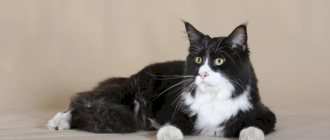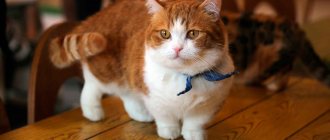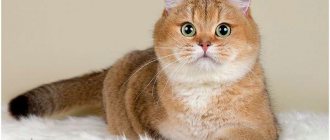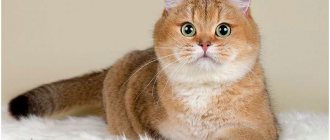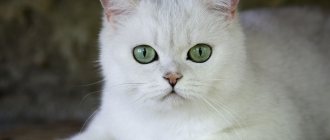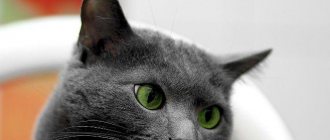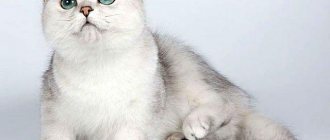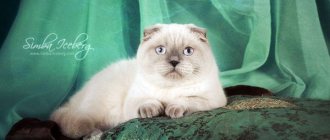Nature has endowed cats with a huge variety of colors. Against the backdrop of a wide color palette, contrasting black and white stands out. It is considered one of the most common and gives animals a special charm and nobility.
Let's figure out which cat breeds are characterized by black and white coloring.
Features of black and white color
Cats with contrasting colors are not very rare and are widespread throughout the globe. Despite its apparent simplicity, the combination of white and black has several important features:
- Uniqueness. This coloring is purely individual, so it is almost impossible to find two black and white cats with identically located spots and stains.
- Spread of color to the paws. A black and white cat may have two-color pads. Their skin is partly dark and partly pink.
- Unusual eyes. Many black and white cats have green tinted irises. Also among them are individuals with heterochromia.
- Dominance of one of the colors. Black and white cats cannot have a uniform color - one color will definitely predominate.
Interesting! In the USA, the black and white color is called “tuxedo”. Americans probably associate it with a classic men's suit, worn with a light shirt. Initially, the phrase “tuxedo color” meant an almost entirely black cat with a white mustache, “slippers” and chest.
Interesting Facts
There are several interesting facts about black kittens with white paws and spots on their bodies. For example, the two-color color of cats was considered a defect for a long time, and only at the end of 1969 were they allowed to participate in exhibitions.
These animals are independent and self-sufficient, thanks to which they are able to survive without outside help. They are resistant to stressful situations and are never the first to show aggression. These animals love people and calmly get along with them under the same roof.
Black and white cats are unusually beautiful pets that are distinguished by their attractive two-tone color. People who want to get such pets should familiarize themselves with their main features and breeds in advance.
Varieties of color
Although all black and white cats appear identical, this is absolutely not the case. There are 3 main varieties of this color:
Wang
With this color, the body of a black and white cat is covered with light hair with several small charcoal marks on the head, muzzle and near the tail of the animal.
Harlequin
Black and white cats with this coloration have light fur with numerous large dark markings. The charcoal pattern can combine stripes, small patterns and large areas of dark fur. The main thing is that the black spot is uniformly colored and does not have white hairs.
Bicolor
The body of an animal with this coloring is covered with blue-black fur with snow-white spots of different shapes and sizes. In the classic version, a bicolor cat has a “tie” in the chest area, as well as light markings on the sides, face and head.
Maine Coon
The Maine Coon is one of the largest cat breeds and is known for its incredible affection. Combined with their distinctive appearance and shiny coat, they are one of the most popular breeds around the world.
Maine Coons are usually tabby, but they come in a variety of colors and patterns, including black and white. These cats usually get along well with all family members, including respectful children and dogs.
They are loyal and affectionate, but not too needy. Maine Coons are known to be expert mousecatchers and may not be suitable for families with small, furry pets.
Color ratio
According to another, more detailed classification, black and white (b/w) color is divided into several types:
- coal-black background without clear light areas with unevenly interspersed white hairs;
- with a charcoal background and small white areas in the neck, chest or lower limbs;
- with a large, clearly defined white patch of fur on the cat's throat;
- with a mark that flows from the chin to the neck of the animal;
- with a uniform light area that starts from the chin and covers the chest, abdomen and all four limbs;
- with white bottom and sides, as well as large black markings on the back, back of the head and tail of the cat;
- with a charcoal tail and small black spots on the back;
- residual black - with several small dark markings on head and tail;
- dominant white - black pigment is present exclusively at the gene level.
Turkish Angora
The elegant, long-haired Turkish Angora was once associated only with white skin color. They are still most often found in this color and come in many other variations, including black and white.
Turkish Angoras are generally best suited to family homes, where they spend most of the day. Sociable and affectionate, they need a lot of attention and enrichment.
They are more active than regular cats and can become mischievous if they get bored. Unlike most cats, this breed often loves to swim and play in the water.
Breeding Features
Getting black and white kittens with the “correct” colors in any breed is very difficult. The difficulties are caused by the fact that in the bicolor color the spots must have beautiful clear outlines and not merge with each other, and the back is darkly pigmented. In addition, black and white cats with symmetrical markings are of particular value. But due to the fact that the localization of spots cannot be predicted in advance, such animals are born very rarely and are more expensive than others.
Black and white kittens arise from the mating of two-colored individuals or a bicolor cat and a cat with a tortoiseshell coat color. Moreover, the shade of the offspring’s fur coat depends on the combination of genes of the parents.
The influence of coloring on character
Albino white giant rabbit: description of the breed
The character of cats that are painted black and white has the following features:
- Sustainability. Even in stressful situations, they behave calmly and do not show aggression.
- Sensuality. Pets with two-colored coats are very sensitive and always understand when to support their owner and be close to him.
- Obedience. Such animals are very obedient and smart, they easily make contact.
Additional Information! Cats first of all think not about themselves, but about their owner. For them, satisfying their own needs does not come first.
Breeds of black and white cats
For a long time, the black and white color remained unrecognized by felinological systems, and purebred cats with a similar color were mercilessly discarded. The situation changed in 1969, when animals with such coats first appeared at the exhibition. Now black and white cats are found in many breeds.
British
For a long period, only blue or smoky colors were cultivated in the breed. But with the popularization of the British, their color range expanded significantly.
In addition to the standard types - van, harlequin and bicolor - among the black and white cats of this breed there are individuals with the unrecognized mitted color. It requires the presence of a light stripe between the chin and groin.
Also, black and white cats of the British breed with a mitted color should have light “socks” or “socks” on their paws.
Oriental
The standard of this breed provides for more than 200 colors, including all black and white variants. Moreover, a van, bicolor and harlequin kitten can be born in one litter. There are many varieties of black and white cats in the breed.
Among the Orientals there are also charcoal individuals with light paws and markings on the face, and snow-white animals with small contrasting spots.
Canadian Sphynx
Bicolor cats are often found among cats of this breed. Moreover, a contrasting pigment colors the skin. Black and white cats of this breed often have a charcoal tail and at least one ear. Sphynx cats are also allowed a symmetrical dark marking on the top of their head.
Kurilian and Japanese bobtails
These tailless cats also have a black and white color, which is characterized by certain features. Bicolors must have a closed white collar on the neck and a light marking on the muzzle in the shape of an inverted V.
Harlequins should have charcoal spots on the forelegs, back and head. Black and white van bobtails have a dark tail and a completely light back.
Kurilian Bobtail
Japanese Bobtail
Maine Coon
These large cats can be black and white in color. Moreover, they are more characterized by the bicolor type, in which most of the body, including the muzzle and ears, is covered in charcoal color.
Among the black and white Maine Coon cats, there are almost no individuals with the “van” and “harlequin” colors, so the cost of such animals can reach several hundred thousand rubles.
Persian
The most common color found in black and white Persian cats is the “harlequin” color, in which 5/6 of the body surface is lightly pigmented. The rest of the body is covered in a rich, cool charcoal color.
For the Persian cat breed, dark whiskers and white hairs on black spots are unacceptable.
Siberian
In addition to the usual variegated colors, the breed allows more than a dozen different colors, including a black and white version. Moreover, a fluffy Siberian can have all three types with clearly defined spots that do not overlap with each other.
The eyes of a black and white cat of this breed are pigmented yellow or green.
Turkish Angora
Although many believe that the Angora is a pure white cat, it also has other color variations. The bicolor breed has light legs, chest, collar, muzzle and belly, as well as a white mark on the forehead that looks like an inverted V.
Manx and Cymric
Tailless cats have many color options, including black and white.
Manx
Cymric
Munchkin
These cute, short-legged cats can have black and white fur. Bicolor munchkins often have light markings on their faces, “socks” on their paws, a “collar” on their necks, and a “tie” on their chests.
Cornish Rex
This figurine-like curly cat also comes in black and white. Moreover, in addition to the three main color options, the breed allows the “tuxedo” color, in which the Cornish’s chest, paws and belly are light, and the top of the head, back, shoulders and sides are charcoal.
The iris of a Rex black and white cat can be blue, yellow, olive or copper.
Turkish van
From the name of the breed it is easy to guess which type of coloring is inherent in these cats. Black and white Turkish Vans have a light body with small dark markings on the head and a charcoal tail.
Manx cat
Like the Cornish Rex, the Manx is dog-like. They are usually playful, sociable, even-tempered and energetic. Manx cats are also intelligent and highly trainable.
This breed is usually tailless, but they sometimes have a short stump. They come in a variety of coat colors, including black and white. This short-haired variety can shed heavily, and with their rounded and shorter back, they may be more susceptible to spinal problems. These cats are also famous for their mousecatching skills.
Rules for caring for black fur
Black fur can fade in the sun, so if you want to maintain the jet black color of your cat's fur, you need to control the amount of time he is exposed to direct sunlight.
Black wool partly requires a special approach. So, you should not let your cat walk for a long time under the scorching sun, as the fur may fade and red spots will appear on the fur coat.
A cat's fur is an indicator of its health. If the fur coat begins to fade and fall out a lot, you should reconsider your pet’s diet and show it to the veterinarian.
Otherwise, the rules of nutrition and care are generally similar for all types of cats, but you need to follow the care features of each breed. For example, Manx cats have a thick undercoat, and therefore need to be combed thoroughly, but bathed no more than twice a year, using special shampoos and conditioners to enhance shine. Maine Coons need to be brushed at least once a week, while Persians and Siberians with long hair require special care. They need to be combed daily in three stages: first with a wide-toothed comb, then with a slicker brush, and finally with a fine-toothed comb. You can bathe them four times a year, after which you treat the wool with a special product to make combing easier.
